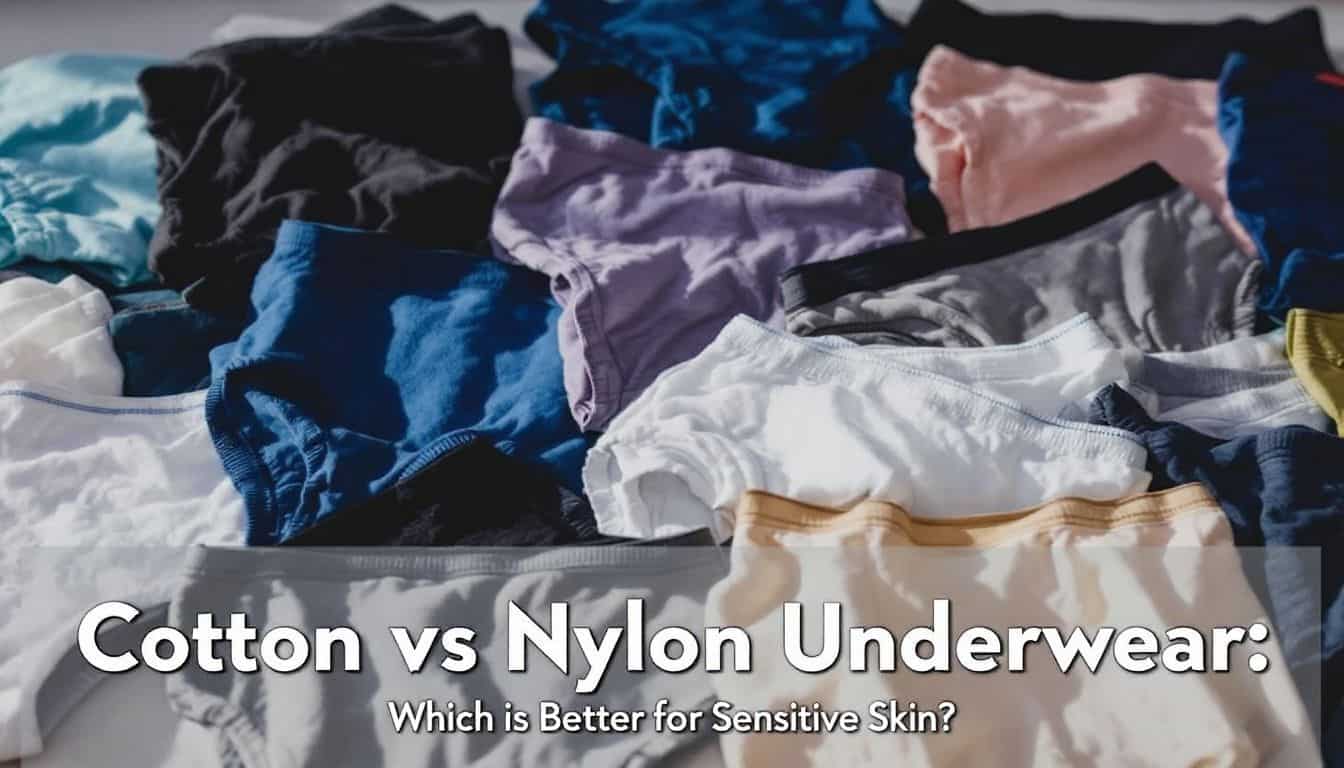Are your undies giving you grief? Sensitive skin can make choosing the right underwear a real pain in the… well, you know where. Cotton and nylon are two popular choices, but which one’s better for delicate derrieres? I’ve got the scoop on these fabrics – and trust me, it’s more than just a bunch of fluff.
Ready to say goodbye to itchy, scratchy unmentionables? Let’s talk panties! 123
Key Takeaways
Cotton underwear is breathable, soft, and absorbs sweat well, making it ideal for sensitive skin. It’s hypoallergenic and helps prevent yeast infections.
Nylon underwear is durable, flexible, and dries quickly. It wicks moisture away from the skin but can trap heat and cause sweating.
Both materials can potentially cause skin irritation. Cotton may shrink or stay damp, while nylon can limit airflow and create a breeding ground for bacteria.
The vagina’s pH should stay between 3.5 and 4.7 for optimal health. Cotton underwear helps maintain this balance better than nylon.
For sensitive skin, cotton is generally the better choice due to its breathability and natural fibers. However, individual preferences may vary based on specific skin needs and activities.
Table of Contents
Comparing Cotton and Nylon Underwear
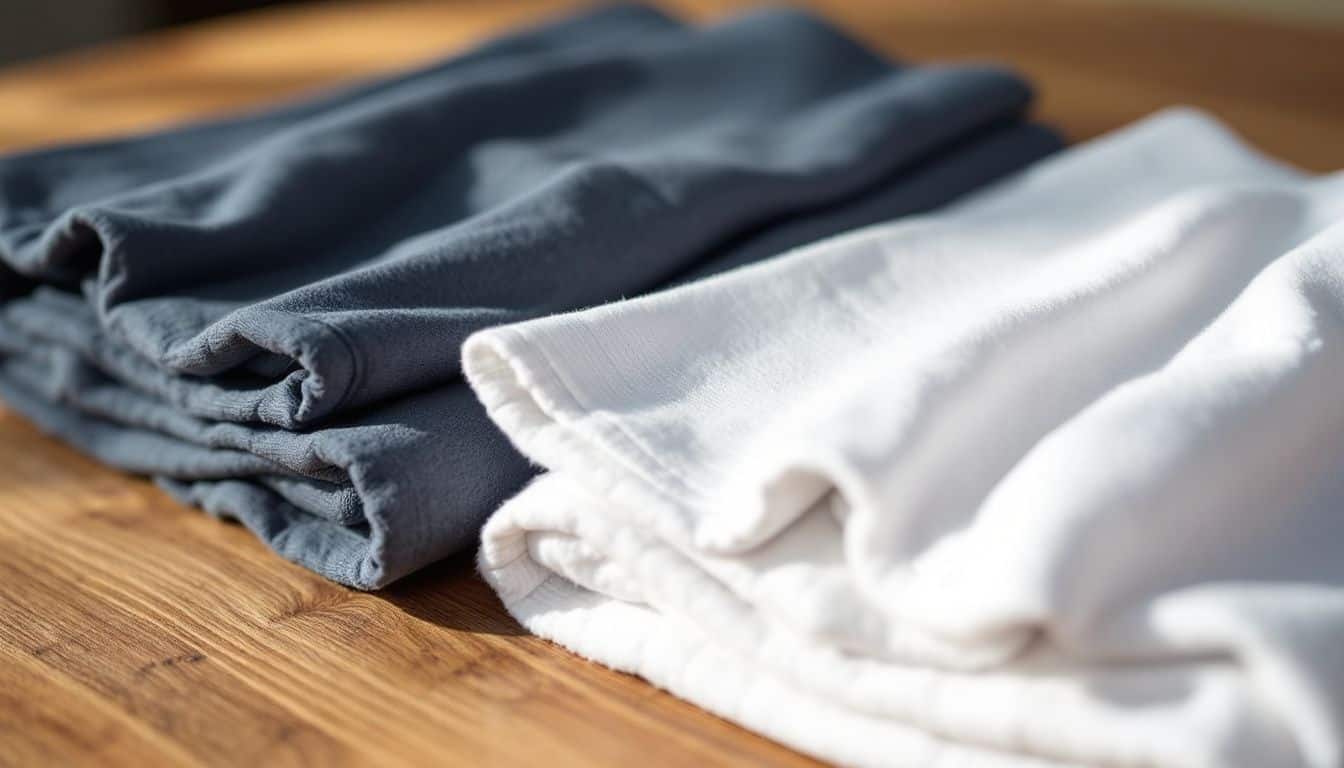
Let’s chat about underwear! Cotton and nylon are two major contenders in the panty world. They’re quite different in terms of how they feel and what they do for your intimate areas.
Properties of Cotton Underwear

Cotton underwear is a fan favorite for good reasons. It’s soft, comfy, and lets your skin breathe. Made from natural fibers, cotton feels gentle against your skin. It’s like wearing a cozy cloud down there! Cotton is also great at soaking up sweat, which helps keep you dry and fresh all day. 1
But cotton isn’t perfect. It can shrink if you’re not careful when washing it. And while it’s super absorbent, it takes its sweet time drying out. This can be a bummer if you’re active or live in a humid place.
Still, many folks love cotton vs nylon for its natural feel and breathability. 2 Now, let’s look at what nylon brings to the table….
Cotton is nature’s hug for your sensitive bits!
Features of Nylon Underwear
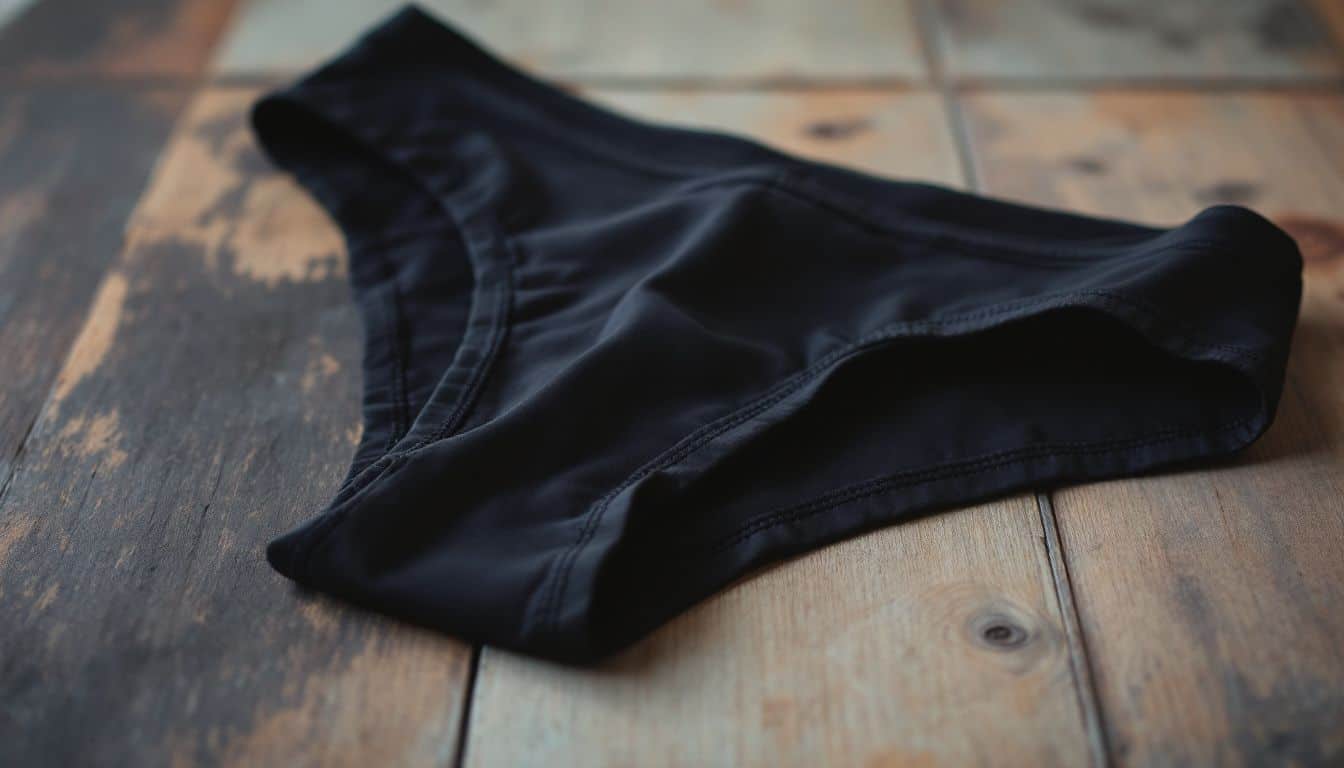
Nylon undies pack a punch in the comfort game. They’re smooth as silk and fit like a glove, giving you that sleek look under clothes. No more panty lines! These babies are tough too.
They laugh in the face of mildew and moths, staying fresh way longer than their cotton cousins. Plus, they’re stretchy – perfect for those days when you’re running around like a headless chicken. 3
But here’s the rub… nylon isn’t the best at letting your skin breathe. On hot, sticky days, you might feel like you’re wearing a plastic bag down there. Yikes! It’s not ideal for sensitive skin either.
The lack of airflow can lead to some not-so-fun issues in your nether regions. So, while nylon undies have their perks, they might not be your go-to for everyday wear if you’ve got finicky skin.
Advantages of Wearing Cotton Underwear

Cotton undies are a game-changer for your lady bits. They’re like a breath of fresh air down there – literally!
Breathability and Comfort of Cotton

Cotton feels like a cool breeze on a hot day. It’s light, airy, and lets your skin breathe. This natural fiber has tiny gaps that allow air to flow freely. Your body heat escapes through these gaps, keeping you comfy all day long.
Plus, cotton soaks up sweat like a sponge. It pulls moisture away from your skin, leaving you dry and fresh. 4
Cotton is nature’s air conditioner for your body.
Comfort is key when picking underwear under a bodysuit or any other clothes. Cotton wins big in this area.
It’s soft against your skin and doesn’t cause itching or irritation. Unlike some synthetic fabrics, cotton won’t make you feel sticky or sweaty. It’s perfect for everyday wear, whether you’re lounging at home or running errands. 4
Hypoallergenic Benefits of Cotton

Cotton rocks for sensitive skin! It’s a natural fiber that’s super gentle and less likely to cause allergic reactions. 5 I’ve found it to be a real game-changer for my own skin issues.
Unlike synthetic materials, cotton doesn’t have harsh chemicals or dyes that might irritate your skin. It’s also great at wicking away moisture, which helps prevent yeast infections and other not-so-fun problems down there.
But here’s the real kicker – cotton lets your skin breathe. 2 This means less sweat and bacteria buildup, which is awesome for keeping things fresh and comfy all day long. Trust me, once you go cotton, you’ll never want to go back to those itchy, synthetic undies again.
It’s like giving your lady bits a cozy, irritation-free hug!
Advantages of Choosing Nylon Underwear

Nylon underwear packs a punch in the comfort department. It’s tough as nails and moves with you like a second skin – perfect for those busy days when you’re running around like a headless chicken.
Durability and Flexibility of Nylon

Nylon underwear is tough as nails. It can take a beating and still look great. This fabric stretches without losing shape, perfect for exotic dancers and gym-goers alike.
I’ve worn nylon undies for years, and they’ve never let me down. They stay put during workouts and don’t bunch up or roll down.
Nylon is like a second skin – it moves with you, not against you. 6
The quick-dry feature of nylon is a game-changer. After a sweaty session, these undies dry in a flash. This makes them ideal for travel or busy days. No more damp, uncomfortable feelings down there.
Plus, nylon’s strength means less pilling and longer-lasting underwear. Your wallet will thank you! 6
Moisture-Wicking Abilities of Nylon

Nylon’s got a cool trick up its sleeve – it’s great at wicking away sweat. This means it pulls moisture from your skin and spreads it out, helping it dry faster. It’s like having a built-in air conditioner for your undies! This feature is super handy for active gals who work up a sweat. 7
Sweat management is key for comfort during workouts or busy days. Nylon underwear shines here, keeping you dry and comfy. It’s a game-changer for women who love to move. Next up, let’s dive into how these fabrics affect your skin’s health.
Impact on Sensitive Skin

Sensitive skin can be a real pain in the… well, you know where. Your choice of undies can make or break your day – it’s not just about looks, but comfort too. Let’s dive into how cotton and nylon affect your delicate areas… and why it matters more than you might think!
Common Skin Irritations from Underwear

Ouch! Itchy, red, and angry skin down there is no fun. Trust me, I’ve been there. Tight undies or scratchy fabrics can make your lady bits feel like they’re on fire. Common culprits? Yeast infections, bacterial vaginosis, and contact dermatitis.
These nasties love warm, moist places – like your underwear. Synthetic materials like nylon can trap heat and sweat, creating a perfect storm for irritation. 8
But don’t worry, it’s not all doom and gloom. Picking the right undies can make a world of difference. Soft, breathable fabrics like cotton let your skin breathe and stay dry. Some women even swear by going commando to give their skin a break.
Whatever you choose, listen to your body. If something feels off, it probably is. Now, let’s talk about how cotton and nylon affect skin moisture levels… 9
How Cotton and Nylon Affect Skin Moisture Levels

Now, let’s talk about how these fabrics handle sweat. Cotton and nylon deal with moisture differently, which can make or break your comfort down there.
Cotton soaks up sweat like a sponge. It’s great at first, but can leave you feeling damp if you’re active, or it’s hot out. I once wore cotton undies to a summer festival – big mistake! By midday, I felt like I was sitting in a wet diaper.
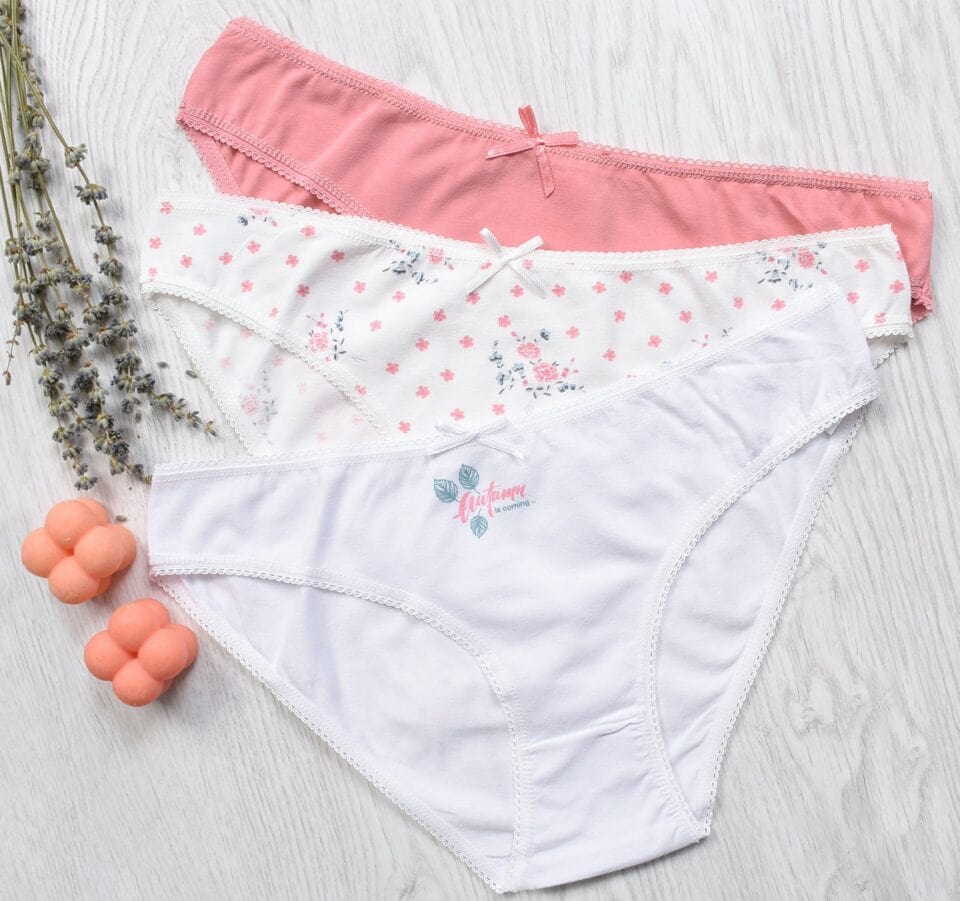
Yuck! 11 Nylon, on the other hand, doesn’t absorb much. It wicks moisture away from your skin, keeping you drier. But it can trap heat and make you sweat more. So, while you might feel less damp, you could end up sweatier overall.
It’s a bit of a trade-off, really. 10
Allergen Potential of Both Materials

Cotton and nylon both have their good and bad points for allergies. Cotton is often thought of as the best choice for sensitive skin. But here’s the thing – it can cause allergies in some people! 10 Sometimes it’s the cotton itself, other times it’s the chemicals used to process it.
Either way, it can make skin itchy and irritated… not great.
Nylon is less likely to cause allergic reactions. But it has its own problems. It doesn’t let air through well, which means sweat and moisture can get stuck. 10 This can create a perfect place for bacteria and yeast to grow.
For women with eczema or psoriasis, cotton and silk are often the top choices. They’re soft on the skin and let it breathe. So, when choosing underwear, it’s all about knowing what works best for your body.
pH Balance Considerations for Intimate Areas
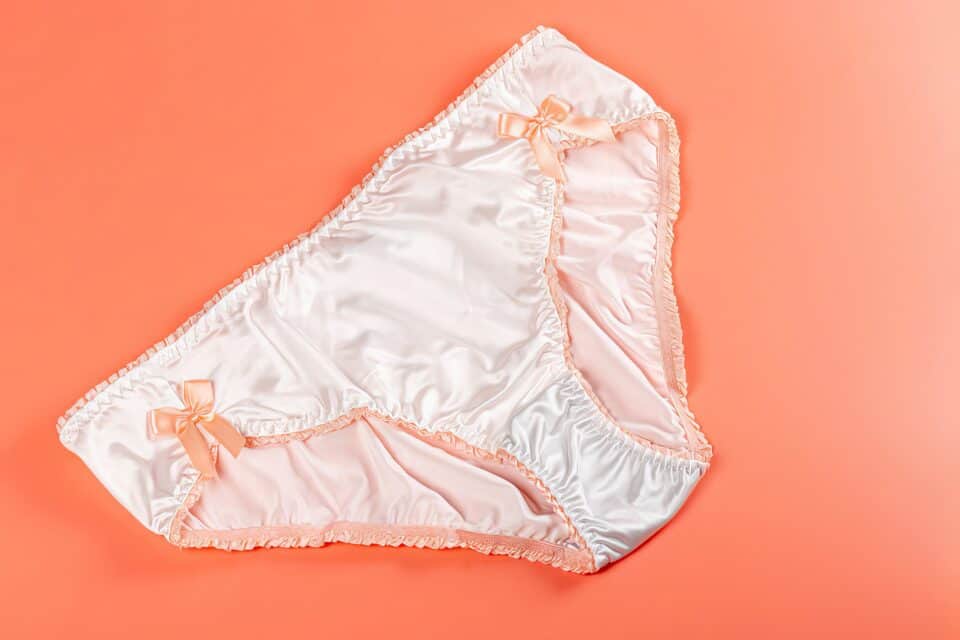
Ladies, let’s talk about your lady parts! Your vulva’s pH is super important. It needs to stay between 3.5 and 4.7 to keep you healthy down there. 12 This acidic environment is like a shield against nasty infections.
Good bacteria, mainly lactobacilli, work hard to keep things in check. But watch out! Soaps, detergents, and tight clothes can mess with this delicate balance. 12
Here’s a fun fact: your vagina is like a self-cleaning oven. It doesn’t need fancy products to stay clean. In fact, those might do more harm than good. Stick to cotton undies during your period to let things breathe.
And if you’re pregnant, keeping your pH in check is extra crucial. A higher pH without infection can up your chances of having your baby too early. So, play it safe and keep things simple down there!
People Also Ask
Is cotton or nylon better for sensitive skin?
Cotton’s a champ for sensitive skin. It’s soft, breathable, and lets your skin breathe. Nylon? Not so much. It can trap heat and moisture, which isn’t great for your delicate areas. Think of cotton as a comfy hammock for your bits, while nylon’s more like a sweaty plastic bag.
What about other fabrics like rayon or modal?
Rayon and modal are like cotton’s cool cousins. They’re soft and comfy too. Modal underwear feels like a dream against your skin. But here’s the kicker – they might not be as tough as good ol’ cotton. Mix it up! Try a cotton gusset with modal sides for the best of both worlds.
Can underwear choices affect vaginal health?
You bet! The wrong undies can lead to vaginitis. Yikes! Breathable fabrics like cotton help keep things dry down there. Synthetic fabrics? They’re like a sauna for your lady parts. Not good. Want to avoid trouble? Stick to natural fibers. Your vagina will thank you.
Are thongs bad for sensitive skin?
Thongs can be tricky for sensitive skin. They’re like a tightrope for your behind. Some folks love ’em, others can’t stand ’em. If you’re prone to irritation, maybe skip the thong and go for full coverage briefs. Or hey, go commando if that’s your thing!
How should I care for my underwear to protect sensitive skin?
Wash ’em gentle and skip the dryer sheets. They can leave a residue that bugs sensitive skin. Air dry if you can – it’s like a spa day for your undies. And don’t forget to change daily. Good hygiene is key for happy skin and a happy you.
Are there eco-friendly options for sensitive skin?
Absolutely! Bamboo fibers are making waves in the underwear world. They’re soft, sustainable, and great for sensitive skin. Hemp fibers are another green option. They’re tough as nails but gentle on your skin. Mother Earth and your sensitive bits will both be grinning.
References
^ https://tbo.clothing/blogs/talk/nylon-underwear-vs-cotton-vs-bamboo-underwear?srsltid=AfmBOoqDYVMmc6RxJWHAVxL6tk6HPtKkBP6WGhfoRbNIEtooQfewj27y (2024-02-28)
^ https://www.tidbitsofexperience.com/cotton-vs-nylon-underwear-which-is-better-for-sensitive-skin/ (2023-01-27)
^ https://tbo.clothing/blogs/talk/nylon-underwear-vs-cotton-vs-bamboo-underwear?srsltid=AfmBOore7FqOVFCP83qKDgz-4hDxXmhUfzzqNFul1SZi3tun6prwBCo3 (2024-02-28)
^ https://www.thirdlove.com/blogs/learn/cotton-vs-nylon-underwear-what-s-the-difference?srsltid=AfmBOooNBzOajPO6VtCsubgnoYiMOy9SsRcGaOj899hW-S8rdohgORAs (2024-08-28)
^ https://www.thirdlove.com/blogs/learn/cotton-vs-nylon-underwear-what-s-the-difference?srsltid=AfmBOoqmFzmsd7lxHfoQd7ycY5KiXjg7Il72xC8ESIkCyU4RhFh5bTDF (2024-08-28)
^ https://www.ufmunderwear.com/articles/benefits-of-nylon-underwear/ (2023-01-29)
^ https://www.mdpi.com/2673-7248/3/3/22
^ https://eczema.org/information-and-advice/triggers-for-eczema/clothing-and-eczema/
^ https://www.today.com/shop/best-fabrics-fibers-sensitive-skin-t242078 (2021-12-13)
^ https://www.ufmunderwear.com/articles/which-material-of-underwear-is-best/ (2024-05-13)
^ https://tbo.clothing/blogs/talk/nylon-underwear-vs-cotton-vs-bamboo-underwear?srsltid=AfmBOorfWEg4bJBNdjG7VvSZiq3dJJs4IUI8tY_AFICPfhDlJ7wXpCYv (2024-02-28)
